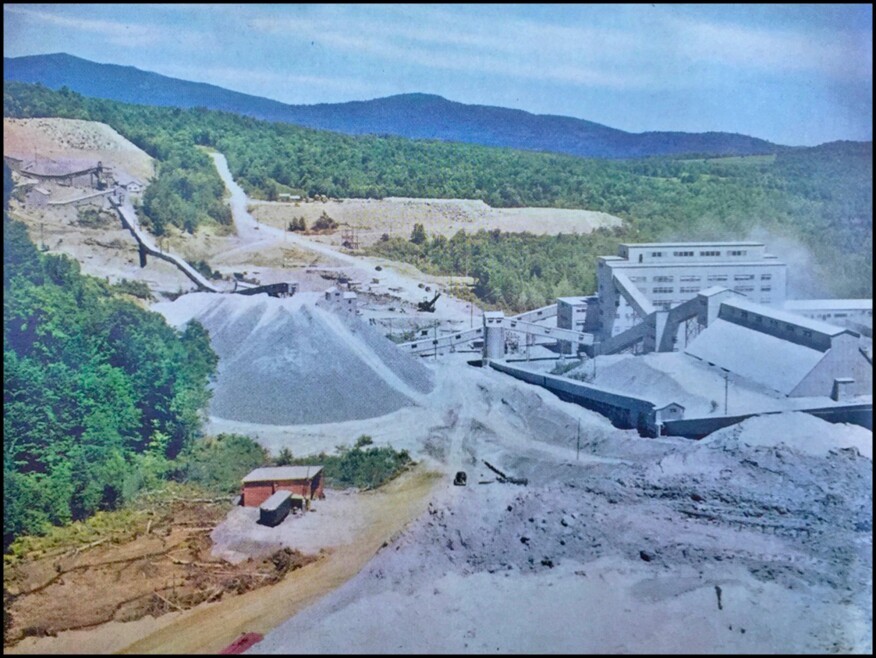
Vermont Life Magazine, Spring 1954
This is a simple multi.
A visit to the posted coordinates is essential viewing, but a physical container right there didn't seem like the best idea. So take in the sight, note the info to add up the numbers for the final, and go get the cache.
LOOK ON MY WORKS, YE MIGHTY...
In 1824 or so, lumbermen working in the forests on Belvidere Mountain discovered curious deposits there. Some of the rocks they turned up were oddly fuzzy. They were a mineral called serpentine, shot through with a naturally-occurring form of fibrous asbestos called chrysotile.
For several decades the substance was intermittently harvested by prospectors as a local resource, until 1901 when the New England Asbestos Mining and Milling Company was formed specifically to explore and exploit this area of the mountain by then known as Cotton Rock. It was the first-ever US company to mine asbestos. In 1936 the growing mine was acquired by the Ruberoid Company, and the operations really took off at a modern industrial scale. Asbestos was marketed as "the magic mineral." With increasing demand to use soft yet durable and heat-resistant asbestos in auto parts, construction materials, fireproofing, and other commercial-grade insulating materials, the Belvidere Mountain mine became one of the very largest producers of white asbestos in the world.
At its peak the open-pit surface mine employed 320 workers. By my back-of-the-envelope math, during that time it produced over a hundred tons of asbestos -- and thousands of tons of tailings & waste rock -- every single day.
...AND DESPAIR!
By the 1960's, increasing attention to environmental issues and accumulated knowledge on the health effects of asbestos exposure led to a 1970 ruling by the Consumer Product Safety Commission. The use of asbestos became restricted in many products like shingles & siding, fireplace liners, and things I'd never even associated with asbestos like crayons and paints. The commercial market for the mineral sagged, and the business looked less and less profitable (the new Clean Air Act meant that environmental retrofits at the mine were also going to be required as well). Due to reduced prospects, in 1973 the owners of the Belvidere and Eden mines scheduled the site operations for closure by 1975.
In an effort to save their jobs, the mine workers themselves organized and raised $2 million dollars to buy the whole concern, as well as install the dust-control and air-pollution measures required by health, safety, and environmental regulations to keep operating. It was seen as a great success, this employee-owned local-industry survival story. The new company, Vermont Asbestos Group, continued to run the mine all through the 1970's and 80's even as markets for asbestos continued to dwindle. In 1989 the EPA effectively banned the use of asbestos in manufacturing of new materials in the U.S.; bankrupted, in 1993 the mine officially, completely, closed for good.
THAT COLOSSAL WRECK...
Today the site is a frightening conglomeration of decrepit industrial buildings, rusting machinery, polluted water, and massive man-made mountains of waste rock and tailings. Storm runoff repeatedly threatens two nearby watersheds, and the multiple water retention ponds are thoroughly contaminated.
In particular, the gigantic and alien forms of the barren gray mine waste -- 30 million tons of it, 350 feet tall and more than half a mile long -- are a blight amongst the Green Mountains and these immense scars in the landscape are visible from miles away.
...BOUNDLESS AND BARE
Plans and proposals for cleaning up the site and/or re-use of parts of the land area have come and gone several times. To date only limited efforts have been made to remediate the environmental dangers posed by the abandoned open-pit mine -- usually in response to an imminent threat posed by a collapsing ore containment structure or a water-control measure in need of shoring up. However, I should emphasize that environmental agencies regard the current situation as stable.
The 1550 acre site is a toxic-waste area and considered to be hazardous inside the property. Obviously, heed the signs -- do not venture beyond the fences or gates, and do not trespass under any circumstances.
This is the scariest place I've ever been to in Vermont.
Final Coordinates:
N 44° 45.AAA, W 72° 31.BBB′
On a prominent sign visible from where you stand at the posted coordinates, there are two numbers. Add 560 to the smaller number, and that's your north minutes AAA. Take the bigger number, subtract 4, and there's your West decimal minutes BBB. Go get the cache after you've had your fill of the ruins of Industry.